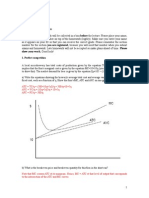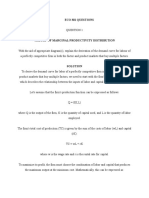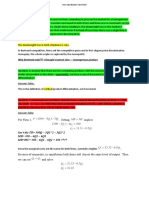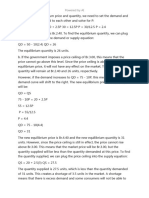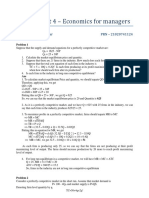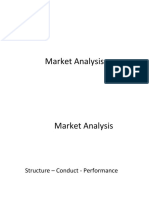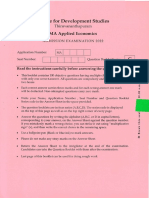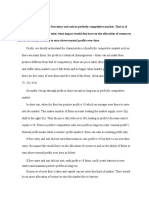0 ratings0% found this document useful (0 votes) 53 views10 pagesMicro Tutorial 5-7
Copyright
© © All Rights Reserved
We take content rights seriously. If you suspect this is your content,
claim it here.
Available Formats
Download as PDF or read online on Scribd
Tutorial 5A Perfect Competition
1) Identify the truthfulness of the following statements for a competitive profit
maximising firm in the short-run:
|. The firm never produces where P < AVC.
Il. The firm never produces where TR < TC.
a. Both | and II are true.
b. Both | and II are false.
c. lis true; Il is false.
d. Lis false; Il is true.
Answer: (c)
2) Identity the truthfulness of the following statements for a competitive profit
maximising firm:
|. Profit maximisation implies that the firm will produce where P = MC.
UI-The firm only produces if P 2 AC in the long run.
a. Both | and Il are true.
b. Both | and Il are false.
c. lis true; Ilis false.
4. Lis false; Ilis true.
‘Answer: (a)
Copyright Ting Mun Kwong�212
3. Consider a competitive industry with several identical firms. You are given
the following information about this industry.
Market demand, Q° = 100 — 5P
Market supply, QS = 20P
Total cost function of a firm, C(q) = 2+ ©
Here P is the market price and q denotes the output of the representative firm
(a) Find the equilibrium market price; the output of each firm; and the number of
firms in the industry.
(b) Would you expect to see entry into or exit from this industry in the long run?
(c) What is the market price at which no further entry or exit would occur and
the industry would be in long run equilibrium.
(d) The government grants a unit subsidy of $1 to every firm. Will this raise the
output of each firm and lower the market price in the long run?
(a) At equilibrium, Market demand = Market supply
So, Q? = QS = 100 — 5P = 20P
P=4 and Q = 20P = 80.
cq)=24+% => MC=q
In a competitive industry, firms produce where P = MC=> 4 = q
Number of firms n= £= = 20
(b) As P =4andq=4, m= Pq—C(q) =4(4)-2-S=6>0
Since the profit is positive, new firms will enter the industry.
(0) In long run, firms are making zero profit.
i =249
Mc=q, AC=i+$
So, MC = AC > it $=q = q=2and-.Ac=2
The long run equilibrium price is 2
4) (q)=2+ £- 4, Mc
1, AC +$-1
So, MC = AC => 4 $-1=q-1 => q=2remains unchanged. *. AC =
The long run equilibrium price, p = 1 is lower than before.
Copyright: Ting Mun Kwong�Tutorial 58 Monopoly
1
‘A monopolist maximises profits when: Select one:
a) Average revenue equals average cost.
b) Average revenue equals marginal cost.
c) Marginal revenue equals average cost.
d) Marginal revenue equals marginal cost.
Answer: (d)
With full (perfect) price discrimination, equilibrium output of the monopolist
is: Select one:
2
) The same as in a non-discriminating monopolist
)_ Less than in a non-discriminating monopolist.
) The same as perfect competi
)) The same as in monopolistic competition.
Answer: (c)
s
eo
Copyright: Ting Mun Kwong.�3. A monopolist has two customers with the following demand functions:
Q=70-P, Demand of customer 1
Q,=110-P, Demand of customer 2
MC = 10 Monopolist's marginal cost
Here Pi is the price charged to customer i and i € {1, 2}
The monopolist has a constant marginal cost of 10, and no fixed costs.
a) Suppose the monopolist can differentiate between the customers, and the customers
cannot trade between themselves, allowing the monopolist to engage in third degree
price discrimination. What is the monopolist’s profit and the price charged to each
customer? What is the total surplus?
b) Now suppose the monopolist cannot differentiate between the customers and must
charge them the same price. Calculate the monopolist's optimal single price P as well
as the quantity sold to each customer. What is the total surplus?
Copyright: Ting Mun Kwong.�Page |3
a) Third degree price discrimination — monopolist charge different prices for different
markets.
Customer 1 Customer 2
P,=70-Q P, = 110-Q
TH = (70 - QQ, = 100, W= (110 — Q2)Q2 — 10Q2
mm = 60Q,- G w= 100Q, — Q3
FE = 60- 20, =0 R= 100- 2Q, =0
Qi = 30, P, = 40. Q2 = 50, P, = 60.
Monopolist's profit, 1 = 1, + mt
= (PAC )Qi — (P2— AC2)Q2 = (40 — 10)30 + (60 - 10)50 = 3,400
P® Customer 1 P Customer 2
110
70
40 60
De
30 a 50 Q
1 1
C8, = 5 (70 ~ 40)(30) = 450. CS, = 5 (110 ~ 60)(50) = 1,250
Total surplus = monopolist's profit + consumer 1 surplus + consumer 2 surplus
= 3400 + 450 + 1250 = 5,100
Copyright: Ting Mun Kwong,�b) It is market segmentation with uniform price.
Q, = 70-P, and Q, = 110-P,
Aggregate demand, Q = Q, + Q: =70-P, + 110-P, = 180 -2P
=90-5Q
1
PQ- TC = (90 - £9) Q— 109 = 809 -+ 2
an ae _
4g = 80- Q=0. ~ Q = 80. SoP = 50.
Q=70-
Q = 110~P = 110-50 = 60
Monopolist’s profit, m= TR — TC = 50(80) — 10(80) = 3,200.
0-50 = 20
P® Customer 1 P Customer 2
110
70
50 50
Dy De
20 a 60 0
Cs; = $ (70 50)(20) = 200. CS, = 5 (110 ~ 50)(60) = 1,800.
Total surplus = monopolist's profit + consumer 1 surplus + consumer 2 surplus
200
Total surplus = monopolist's profit + consumer 1 surplus + consumer 2 surplus
= 3400 + 450 + 1250 = 5,100
= 3200 + 200 + 1800 =
The total surplus under single pricing is higher as 5,200 > 5,100. The single pricing
extracts lesser consumer surplus than that under price discrimination.
Copyright: Ting Mun Kwong.�Page |1
Tutorial 6 Oligopoly
1
Which market structure is characterised by a long-run equilibrium where
price is equal to average cost, but is greater than marginal cost and
marginal revenue?
a) perfect competition
b) monopolistic competition
©) oligopoly
d) monopoly.
Answer: (b)
It an imperfectly competitive firm is producing a level of output where marginal
cost is equal to marginal revenue, marginal revenue is below average variable
cost, and price is equal to average total cost, then the firm:
a) should shut down
b) should decrease output, but should not shut down
c) should increase output
d) none of the above is correct
Answer: (d)
Copyright: Ting Mun Kwong�212
3. Suppose there are two identical firms in an industry. The output of firm 1 is
denoted by qi and that of firm 2 is denoted by qe. Each firm can produce output at a
constant marginal cost of 3. There are no fixed costs.
The inverse demand curve is given by P = 30 — Q, where P is the market price.
a) Find the Cournot-Nash equilibrium quantity produced by each firm and the market
price.
b) Suppose firm 2 can only produce 3 units due to licensing regulation, how much
will firm 1 produce?
©) Suppose the two firms collude and share the profit equally. Find the market
output, price, and profit of each firm.
d) What would be the quantities produced by each firm and market price under the
Stackelberg duopoly if firm 1 moves first?
a) m = Pai — C(q1) = (30 - gi ~ G2 — 3)q1 = (27 — G1 ~ G2)
28 = 27-2q,-q2 =0. eq(1)
dar
By symmetry, due to similar cost function, qz = =... ...eq(2)
Solving equations (1) and (2), qi = a -q; =9. Substitute into eq(1), q2 =9
Market quantity, Q = q; + q2 = 18. Market price, P= 30 — 18 = 12
b)qi=
c) The monopoly profit function, 1 = (P — 3)Q = (30- Q-3)Q = (27- QQ
Sh = 27-2Q=0. .Q=135. P=30-Q= 165
w= (27 -QQ= (27 — 13.5)13.5 = 182.25
18225 _ 91 4)
«Profit of each firm, m =
d) From eq(2), q2
Firm 1 profit function, m; = (30 — qi — 42 — 3)q: = (27-41 - anor
Substitute qz = 7%
(13 5 a )a
zap
2-4
into m, :
-a Ja:
= 6.75
28 = 135-qi:=0. -.q,:=135 and qo
Q= a1 +42 = 20.25. P= 30-2025 = 9.75
Copyright: Ting Mun Kwong�Tutorial 7 General Equilibrium
1. In an Edgeworth Box, a reallocation of resources from the initial endowment to
any point on the contract curve always constitutes a Pareto improvement.
Which of the following statements is correct?
{a) True, if the initial endowment bundle is on the contract curve.
(b) True, as every point on the contract curve is Pareto efficient.
(c) False, if the initial endowment bundle is on the contract curve.
(d) True based on the Second Welfare Theorem of welfare economics.
(c) is correct.
2. Consider an exchange economy with two goods (1 and 2) and two consumers (A
and B). There are 8 units available of each of the two goods.
Agent A is endowed with 3 units of X and 3 units of Y.
Suppose the utility functions of agents A and B are U = X°5y°s
The figure shows an Edgeworth Box for this exchange
Which of the following statements is correct?
Good X Agent B
9
8
Contract curve
Good Y
Us: --)
Use
3
0 3 3
Agent A Good X
(a) The endowment bundle is bundle C.
(b) The endowment bundle is bundle A and is Pareto efficient.
(c) The endowment bundle is not Pareto efficient because agent A can become
better off by trading to point D on the contract curve
(d) Agent's B endowment is 5 units of X and 4 units of Y.
(b) is correct.
Copyright: Manfred Ting Mun Kwong�212
3. Consider an exchange economy with two goods (tea and milk) and two
consumers (A and B). There are 10 units available of each of the two goods.
Consumer A is endowed with 6 units of tea and 4 units of milk. Consumer B is
endowed with 4 units of tea and 6 units of milk. The preferences of the two
consumers are as follows.
Consumer A uses a unit of milk with each unit of tea. Tea and milk are perfect
complements for him
Consumer B drinks milk and tea separately, and the two goods are perfect
substitutes for her.
Draw an Edgeworth box and show the area of mutually beneficial trades between the
two consumers.
Milk and tea are perfect complements for consumer A. Hence, consumer A’s
indifference curves are L shaped
Milk and tea are perfect substitutes for consumer B. Hence, consumer B's
indifference curves are downward sloping straight lines.
Tea 4 Fi
Milk Milk
Mutually «
beneficial
trades - lo
g Tea
The endowment point is at point E(6,4). The triangle EYZ is the area of mutually
beneficial trades where Consumer A and B can be made better off. Hence point E is
Pareto suboptimal.The contract curve is the dashed line, and the line ZA is the part
of the contract curve on which equilibrium trades lie
Copyright: Manfred Ting Mun Kwong


